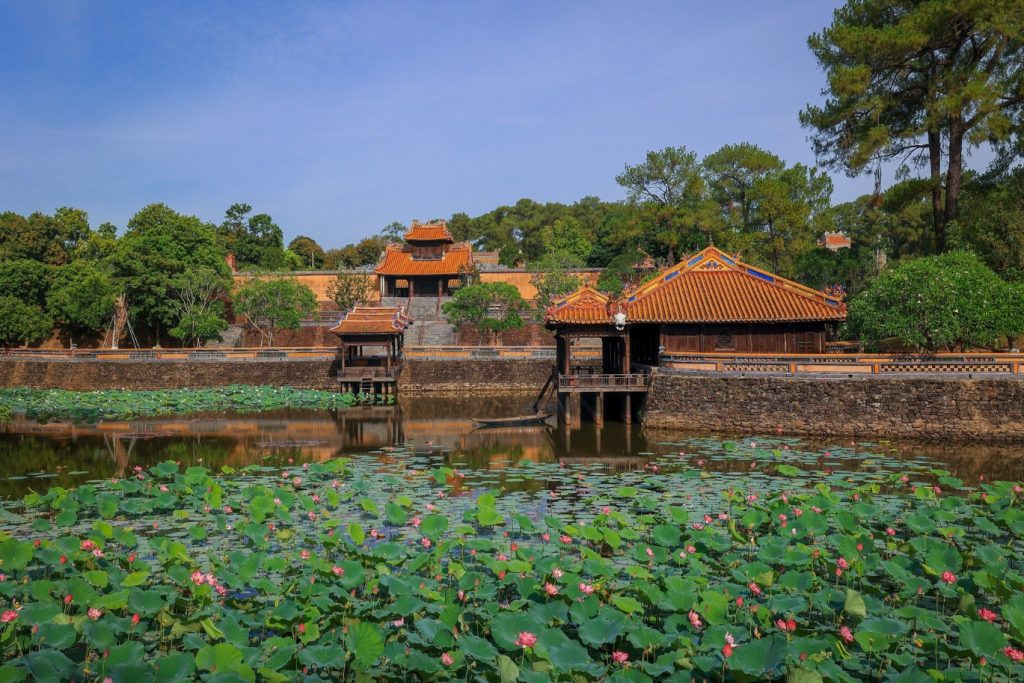
It’s like stepping out of a super fancy, gold-painted picture! Tu Duc Tomb has this really quiet, graceful beauty, almost like it belongs to a poet. Every tree branch, every blade of grass, and even the colors of the buildings just feel so gentle and artistic.
Honestly, this place is totally unique. You can really feel the thought and care that went into building it. Maybe that’s why Tu Duc Tomb is always such a popular spot for visitors when they come to Hue.
Tu Duc Tomb – A Poet’s Masterpiece
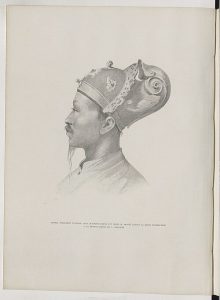
Tu Duc Tomb is located near Dong Ba Bridge, in Thuong Village, Hue City. It’s about 5 kilometers southwest of downtown Hue. This place was actually both a royal retreat and the final resting place for Emperor Tu Duc, who was the fourth emperor of the Nguyen Dynasty.
The tomb sits on a small hill, surrounded by peaceful, quiet nature – pine forests and mountains all around. This spot isn’t just good for feng shui; it also creates this really grand, majestic view that totally highlights how impressive the whole place is.
Construction on Tu Duc Tomb started in 1864 and took a whopping 12 years to finish, wrapping up in 1873. Building it was a huge undertaking, especially with all the political and social chaos back then. Thousands of workers, artisans, and engineers were involved.
II.What's So Special About Tu Duc Tomb? And Why Do People Love Visiting It So Much?
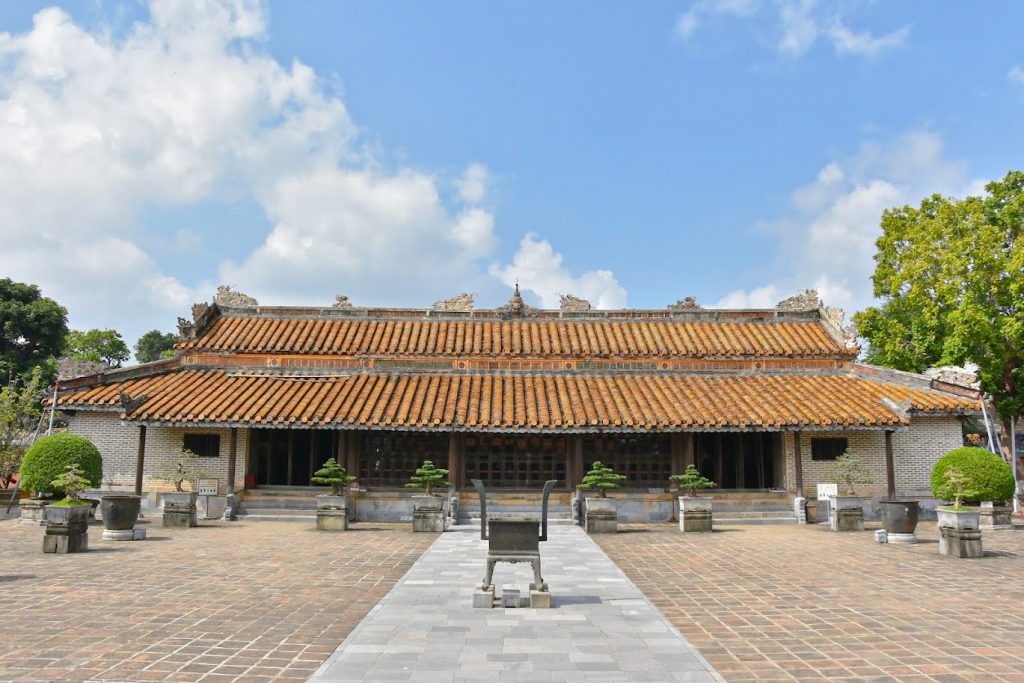
Just like other early dynasty tombs, Tu Duc Tomb has that classic, traditional architecture, following all the Confucian tomb-building rules. But somehow, this tomb has a really special charm, not just for tourists but even for local people.
1. The Only Tomb with a Black Color Scheme
Unlike the traditional early dynasty tombs that are usually super vibrant with bright red and yellow, Khiem Lang (which is another name for Tu Duc Tomb) feels humble and elegant with its natural black wood color. It gives you a calm feeling from the moment you step inside.
The reason for this might be that Khiem Lang was originally Khiem Cung, built by Emperor Tu Duc as a private resting spot for himself and his family on special occasions. But Tu Duc wasn’t the only emperor with a private palace. Before him, Emperors Minh Mang and Thieu Tri also had their own palaces, like Khanh Ninh Palace and Bao Dinh Palace, where they could relax after court duties or just chill out.
Because of this, the entire palace area has that original rustic feel. It wasn’t meant to be a grand, ceremonial building painted in red and gold like Thai Hoa Palace or Can Chanh Palace in the Imperial City. This was specifically for the emperor to relax, so there’s no red lacquer and gold leaf decoration inside.
You can actually see this in other similar palace buildings that are still around today, like the main hall of Dien Tho Palace (where empresses dowager lived) or Long An Palace (the main hall and residence of Emperor Thieu Tri at Bao Dinh Palace). None of them have that red lacquer and gold leaf. But ceremonial halls like Can Chanh Palace and Thai Hoa Palace are always vibrantly red.
2. Traditional Architecture with Thoughtful Touches
The unique architecture of Tu Duc Tomb is a perfect example of how Nguyen Dynasty architecture blended with Eastern cultural elements, especially influences from Chinese, Confucian, and Buddhist cultures.
The tomb is designed in the shape of the Chinese character “Công” (工), which basically means it has different sections, each with its own purpose, creating a very solemn space that harmonizes with nature. The tomb complex is divided into two main parts, arranged on two parallel axes. It uses Giang Khiem Mountain in front as a “front altar” (like a natural screen), Duong Xuan Mountain as a “back cushion” (for support), and Luu Khiem Lake as a “bright mirror” (a symbolic body of water).
The first standout point is the clever use of feng shui principles: the tomb is built on a hill with a lake and trees all around, bringing balance and harmony between nature and the built environment.
What’s really cool is that almost 50 structures within Tu Duc Tomb, in both the worship and burial areas, have the word Khiem in their names. Like Vu Khiem Gate, Khiem Cung Mon, Chi Khiem Duong, Luu Khiem Lake, Xung Khiem Ta, Du Khiem Ta, Hoa Khiem Palace… it’s everywhere!
Here are some must-see spots if you visit Khiem Lang:
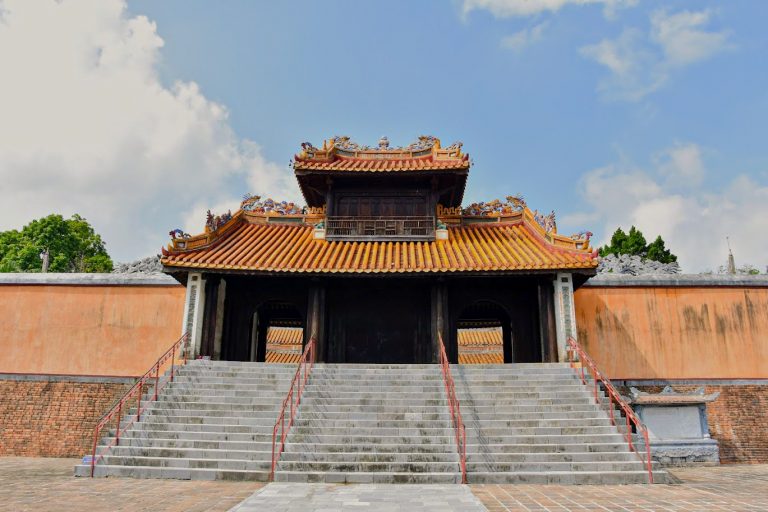
Khiem Cung Gate
Khiem Cung Mon is a two-story gate that looks like a watchtower. This was the area where the emperor would rest whenever he visited Tu Duc Tomb. Right in the middle is Hoa Khiem Palace, with Phap Khiem Vu on the left and Le Khiem Vu on the right.
Stepping through this gate, visitors feel like they’ve entered another world – quiet, peaceful, and totally separate from the busy life outside.
Xung Khiem lake
Xung Khiem Ta (where the emperor would relax, enjoy the breeze, write poetry, and appreciate art) and Du Khiem Ta (the boat landing for the emperor when he went out to enjoy the scenery on Luu Khiem Lake) are two unique architectural structures within the overall Tu Duc Tomb complex, and really, the Hue Imperial City Monuments as a whole.
These are always the most popular spots because of their romantic, picturesque beauty. You absolutely have to get a photo here when you visit Tu Duc Tomb!
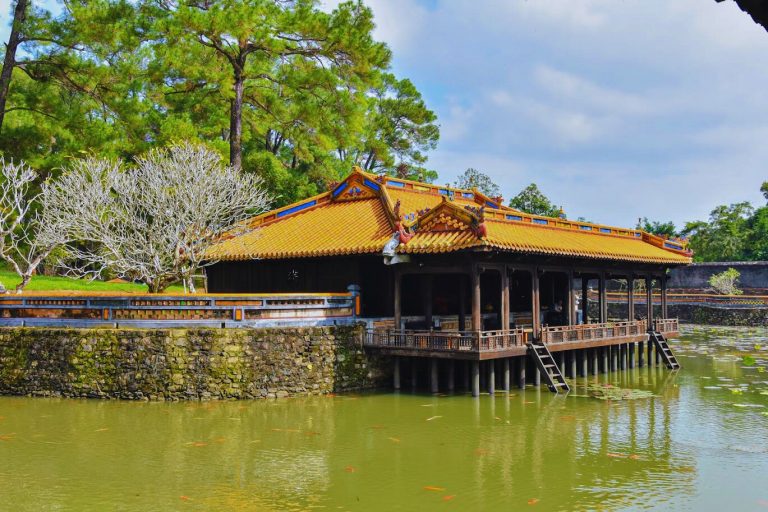
2.3 The Story Behind the Name “Khiem Lang”
Emperor Tu Duc ruled during a really tough time. There were foreign invaders attacking from outside, and inside, his brothers were fighting over the throne. Plus, the emperor himself was sick and couldn’t have children. It’s like he built this tomb complex as a second court, a place where he could escape the harsh reality and find some peace and quiet.
When construction first began, Emperor Tu Duc named the project “Van Nien Co.” But because building it caused so much hardship for the soldiers and laborers, draining money and manpower, and combined with the “Chay Voi” rebellion led by the Doan Huu Trung brothers, the emperor changed the name to Khiem Cung (Khiem meaning “humble” or “modest”). It was like his way of showing regret and apologizing for the suffering of his people. After the emperor passed away, the complex was then called Khiem Lang.
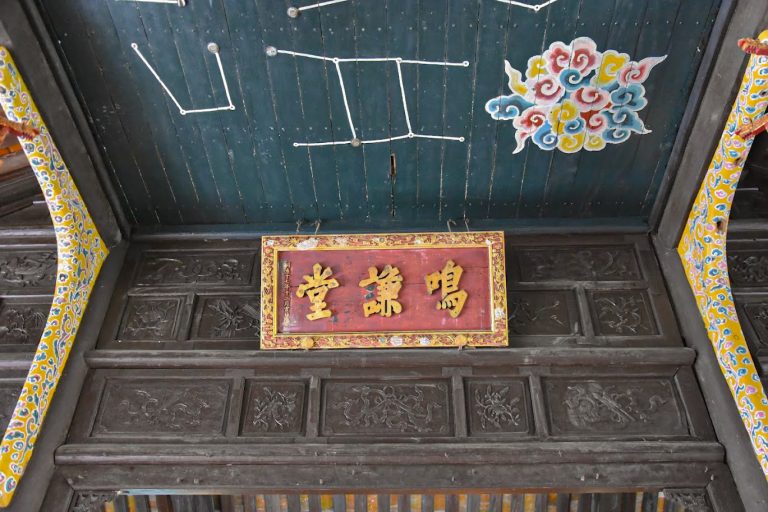
2.3 The Story Behind the Name “Khiem Lang”
Reigning as emperor amidst a challenging social backdrop, with foreign invaders attacking from without, internal strife among siblings vying for the throne, and the emperor himself suffering from chronic illness and childlessness – as if to escape this harsh life, Emperor Tu Duc had this tomb complex built as a second imperial court – a sanctuary where he could find moments of peace and tranquillity.
When construction first began, Emperor Tu Duc named the complex Van Nien Co. However, the construction caused immense hardship to soldiers and labourers, exhausting both funds and military resources. Coupled with the Chay Voi uprising led by the Doan Huu Trung brothers, the emperor changed the name to Khiem Cung (Khiem meaning humble, humility), as an expression of his regret and apology for the suffering of his people. After the emperor’s death, the complex became known as Khiem Lang.
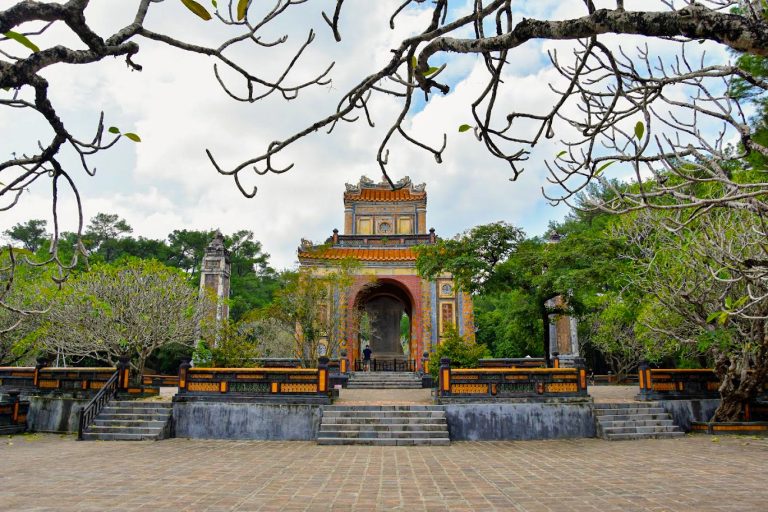
III. How to Get There
Tu Duc Tomb (Khiem Lang) is really close to the city, so you can totally get there by motorbike, bicycle, or whatever transport is convenient for you. For a super comfortable experience, though, I’d recommend a private car.
IV. Ticket Prices and Opening Hours
For visitors: 150,000 VND per adult, and 50,000 VND per child.
The tomb is open from 6:30 AM to 5:00 PM in summer and 7:00 AM to 5:00 PM in winter.
V.Tips for Visiting the Tomb
When you visit Emperor Tu Duc Tomb, here are a few important things to keep in mind to make your trip enjoyable:
- This is a historical and cultural site, so please dress modestly and respectfully.
- The tomb area is pretty big, so make sure to wear your most comfortable shoes!
- The best time to visit is in the early afternoon when the light is just right for taking some really stunning photos.
VI. Nearby Attractions Not to Be Missed
Around Tu Duc Tomb, there are lots of other cool tourist spots that draw visitors. A couple of popular ones include:
- Vong Canh Hill: This is a famous viewpoint in Hue. From the top of the hill, you’ll get to see amazing natural scenery, along with other ancient buildings nearby like Tu Duc Tomb and Thien Mu Pagoda.
- Thuy Xuan Incense Village: This is an ecotourism area that attracts a lot of visitors. It has many homestays and resorts, plus outdoor activities like elephant riding, boating, and fishing for you to relax and have fun.
- Dong Khanh Tomb: This place was built to remember and protect the legacy of Emperor Dong Khanh, who was the 9th king of the Nguyen Dynasty
VII. Conclusion
Honestly, Emperor Tu Duc’s tomb complex is like its own little world, just full of peace, nature, and amazing harmony within the whole Hue Imperial City group of buildings. Sitting right on the edge of the old capital, Tu Duc Tomb is a super special cultural heritage site for Vietnam. You could even say it’s the most beautiful and best-preserved tomb among all seven of the Nguyen emperors’ tombs, and it’s even considered one of the most stunning architectural works of the 19th century.


